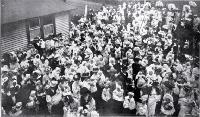
St Helen’s Hospital used to stand at 20 Battersea Street, on the south-west corner of Battersea and Durham Streets, Sydenham, Christchurch. It began life as a hotel, then became a maternity hospital and later a rest home before its’ demolition in 1982.
Beginning as the Sydenham Hotel
The building was erected about 1890 as the Sydenham Hotel, but the licence was not renewed in 1891, as the Licensing Committee felt that the licensing of the premises is not required in the neighbourhood.
This was at the height of the power of the prohibition movement.
The Hotel becomes a hospital
Presumably the building stood empty until 1907, when it was bought by the government and the hospital opened that same year. Known as St Helen’s Hospital, it was administered by the Christchurch Hospital Board and used as a birthing unit for respectable, married, women: wives of the working class men of the borough.

The Right Honourable Richard John Seddon (1845-1906), was the founder of the St. Helen’s Hospitals movement throughout New Zealand. It started a move to dedicated maternity hospitals rather than actual hospitals. Seddon was particularly interested in the proper training of midwives. The hospitals were named after Seddon’s birthplace, a town in Lancashire, near Liverpool.
A scathing report on the state of the building at the time described it as one of the most unsuitable places that could have been chosen… it was a very old dilapidated building standing in the typhoid area of Sydenham and placed at the corner of a busy street, where carts rumbled by all day, and alongside the Salvation Army barracks, where they banged the drum all the evening.
In contrast, the Hon. G. Fowlds said he disagreed with every word… at the present time it was the best-equipped and most suitable institution in the colony for a maternity home.

A new maternity hospital
Forty years passed before a new and purpose-built maternity hospital was opened in Colombo Street in 1952. The name St. Helen’s was transferred to the new building and in 1968 the name was changed to Christchurch Women’s Hospital.
The building becomes a rest home
Ironically the next owner was the Canterbury Aged People’s Welfare Council Inc, who converted it to a rest home and moved in 30 elderly men and women. Men were housed in the former bedrooms, the lounge was the former Sydenham Hotel bar, and women were accommodated in what had been the Nurses’ Home in an adjoining building. It was named Langford House, after Thomas Herbert Langford (1891 - 1952) who helped the Aged People’s Welfare Council considerably in conjunction with the City Council’s housing committee.
He was the public relations officer for the Christchurch City Council.

The rest home closes
Soaring upkeep costs and the fact that the elderly residents had always had to be subsidised by the Aged People’s Welfare Council led to the Council’s reluctant decision in 1981 to close the House and sell it. By now there were several homes for the elderly in Christchurch and the Council ensured that all residents were comfortably rehoused before changing its focus to welfare without immediate involvement in Homes. After a farewell party on 26 February, the building was closed and offered for auction.
Demolition
The building, which had been stripped back to its bare form… with its woodwork stuccoed over [was] of such little character that there was no reason to regret its eventual demolition
in 1982 and the site was then occupied by Leopard Coachlines Ltd as a bus parking yard until 1999 before again being built over. Later it was the premises of an auto electrical firm, with its parking area neighbouring Blackheath on the Durham Street frontage.
Sources
- Annual reports on St. Helens hospitals appear in the Appendices to the journals of the House of Representatives, H-22, 1907-1910; H-31, from 1911
- Archives New Zealand, Christchurch holds records for St Helen’s / Christchurch Women’s Hospital, 1907-83
- Canterbury Aged People’s Welfare Council, Inc. 1982, Annual report for year ending 31st December
- K. Drayton, Christchurch Women’s Hospital: the first 15 years
- J. Wilson, Lost Christchurch
- “Decision of the committee, six hotels to be closed”, The Canterbury Times, 18 June 1891, p 39
- “St. Helen’s Hospital, the institution closed, an alleged unsuitable building”, The Press, 2 November 1908, p 7
- “Maternity Hospital: a new St Helens”, The Press, 6 October 1919, p 6
- “New hospital opened, large crowd at St. Helen’s, patients to move in on July 7”, The Press, 23 June 1952, p 2
- “St Helens hospital: ladies committee’s plea for new building”, The Press, 9 August 1930, p 2
- “Death of Mr T. H. Langford, collapse when swimming, Christchurch Public Relations Officer” and “St. Helen’s Hospital, resident doctor to be appointed”, The Press, 30 December 1952, p 6
- “Old St Helens Hospital: acceptance as home for aged: decision of Welfare Council, The Press, 22 September 1953, p 7
- “30 elderly persons now living in Langford House”, The Press, 13 July 1956, p 16
- “Change of name for St Helens Hospital”, The Press, 23 November 1967, p 6
- “Langford House closes”, The Press, 4 March 1982, p 6
- “Langford House demolished”, The Press, 23 September 1982, p 23
Other resources
- Richard John Seddon
- George Fowlds
- Liquor laws background to the prohibition movement

